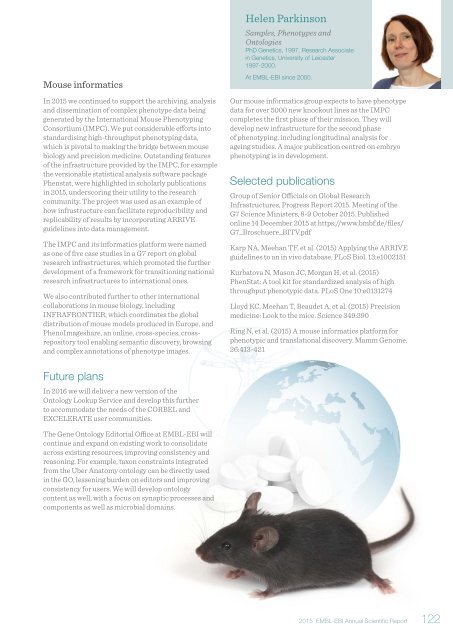Annual Scientific Report 2015
EMBL_EBI_ASR_2015_DigitalEdition
EMBL_EBI_ASR_2015_DigitalEdition
Create successful ePaper yourself
Turn your PDF publications into a flip-book with our unique Google optimized e-Paper software.
Mouse informatics<br />
In <strong>2015</strong> we continued to support the archiving, analysis<br />
and dissemination of complex phenotype data being<br />
generated by the International Mouse Phenotyping<br />
Consortium (IMPC). We put considerable efforts into<br />
standardising high-throughput phenotyping data,<br />
which is pivotal to making the bridge between mouse<br />
biology and precision medicine. Outstanding features<br />
of the infrastructure provided by the IMPC, for example<br />
the versionable statistical analysis software package<br />
Phenstat, were highlighted in scholarly publications<br />
in <strong>2015</strong>, underscoring their utility to the research<br />
community. The project was used as an example of<br />
how infrastructure can facilitate reproducibility and<br />
replicability of results by incorporating ARRIVE<br />
guidelines into data management.<br />
The IMPC and its informatics platform were named<br />
as one of five case studies in a G7 report on global<br />
research infrastructures, which promoted the further<br />
development of a framework for transitioning national<br />
research infrastructures to international ones.<br />
We also contributed further to other international<br />
collaborations in mouse biology, including<br />
INFRAFRONTIER, which coordinates the global<br />
distribution of mouse models produced in Europe, and<br />
PhenoImageshare, an online, cross-species, crossrepository<br />
tool enabling semantic discovery, browsing<br />
and complex annotations of phenotype images.<br />
Helen Parkinson<br />
Samples, Phenotypes and<br />
Ontologies<br />
PhD Genetics, 1997. Research Associate<br />
in Genetics, University of Leicester<br />
1997-2000.<br />
At EMBL-EBI since 2000.<br />
Our mouse informatics group expects to have phenotype<br />
data for over 5000 new knockout lines as the IMPC<br />
completes the first phase of their mission. They will<br />
develop new infrastructure for the second phase<br />
of phenotyping, including longitudinal analysis for<br />
ageing studies. A major publication centred on embryo<br />
phenotyping is in development.<br />
Selected publications<br />
Group of Senior Officials on Global Research<br />
Infrastructures, Progress <strong>Report</strong> <strong>2015</strong>. Meeting of the<br />
G7 Science Ministers, 8-9 October <strong>2015</strong>. Published<br />
online 14 December <strong>2015</strong> at https://www.bmbf.de/files/<br />
G7_Broschuere_BITV.pdf<br />
Karp NA, Meehan TF, et al. (<strong>2015</strong>) Applying the ARRIVE<br />
guidelines to an in vivo database. PLoS Biol. 13:e1002151<br />
Kurbatova N, Mason JC, Morgan H, et al. (<strong>2015</strong>)<br />
PhenStat: A tool kit for standardized analysis of high<br />
throughput phenotypic data. PLoS One 10:e0131274<br />
Lloyd KC, Meehan T, Beaudet A, et al. (<strong>2015</strong>) Precision<br />
medicine: Look to the mice. Science 349:390<br />
Ring N, et al. (<strong>2015</strong>) A mouse informatics platform for<br />
phenotypic and translational discovery. Mamm Genome.<br />
26:413-421<br />
Future plans<br />
In 2016 we will deliver a new version of the<br />
Ontology Lookup Service and develop this further<br />
to accommodate the needs of the CORBEL and<br />
EXCELERATE user communities.<br />
The Gene Ontology Editorial Office at EMBL-EBI will<br />
continue and expand on existing work to consolidate<br />
across existing resources, improving consistency and<br />
reasoning. For example, taxon constraints integrated<br />
from the Uber Anatomy ontology can be directly used<br />
in the GO, lessening burden on editors and improving<br />
consistency for users. We will develop ontology<br />
content as well, with a focus on synaptic processes and<br />
components as well as microbial domains.<br />
<strong>2015</strong> EMBL-EBI <strong>Annual</strong> <strong>Scientific</strong> <strong>Report</strong> 122


